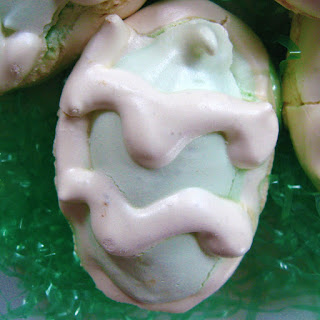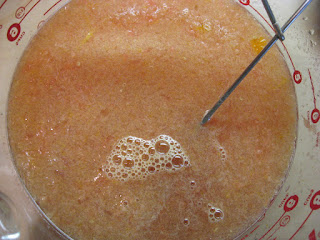I was a young teenager the first time I tasted peach poppy seed bread. My grandparents (mother's parents) traveled all over, and often, but one place they particularly loved was Taos, New Mexico. Sometimes they'd bring the family along for a couple of weeks on their Taos trips. One time they just brought my brother and me, for nearly a month. I was 15 on that trip, but I'd tasted this bread a year or two before.
I'm filled with a myriad of memories when I think of Taos. I won't go into all of those here, but I will tell you that food was among them. My grandmother appreciated great food and we discovered some amazing places and tastes on those trips.
There was a cafe on the outskirts of Taos that we discovered one summer. If any of you are Taos natives, maybe you can tell me for sure, but I believe the name was Northside Cafe? I tried googling such a place and it apparently doesn't exist anymore. They served amazing green chile chicken enchiladas and some delicious peach poppy seed bread.
On future trips to Taos, we would have these enchiladas and bread for at least one of our meals. I know the combination of enchiladas and peach poppy seed bread probably doesn't sound like the best, but for some reason it worked for us back then.
Sometimes we would order a meal to go, and eat it as a picnic on a hike through the mountains or along the river. My grandmother would cut everything up into portions and serve them to each of us. I still remember how she would hold the knife and cut each thick slice of bread/brownie/cake/whatever into smaller rectangles. We would secretly joke how sometimes she would cut a larger portion for herself. She lost her battle to cancer 10 years ago at quite a young age, but I still miss her.
Memories, good and bad, often involve food. This is one of the reasons that sometimes when we discover a way to make something, we get so excited about it. It's not just the taste, texture, smells and colors that excite us, but also the memories that are evoked when we rediscover something familiar yet distant.
It was this way for me when I learned about the Gluten-Free Ratio Rally that some amazing food bloggers came up with. Ratio baking allowed me to recreate the peach poppy seed bread from years ago.
The Ratio Rally posts began last month with various gluten-free pancakes. You can read about how it started, as well as a pancake recipe and links to all participating pancake recipes,
in this post by Shauna James Ahern from Gluten-Free Girl and the Chef.
(This month's host is
Silvana's Kitchen, where all the links are found for participants. More about that and her amazing recipe can be found at the bottom of this post if you want to scroll to it.)
Because this is my first Ratio Rally post, I'll take a moment to explain my reasons for getting behind this. The idea is based around the fact that each type of flour weighs a different amount. Rice flour is going to weigh a different amount than tapioca starch, for example, and for those of us who have to bake gluten-free, all of these different combinations of flours that are necessary for successful gluten-free baking most definitely weigh a different amount than wheat flours. When we try to convert a recipe calling for regular, all-purpose wheat flour to a gluten-free product, it's often a long process with much failure because of this. When you use the flours according to their weight, however, your chances of success improve. And you can even leave out things like xanthan gum.
(To see how I finally got success with a cake recipe using the weight idea that I'd failed at for two years with measuring, see this post.)
When I started reading the rally posts last month, I became excited about the possibility of taking this weight for the flours idea and taking it to the next level with weight for each main ingredient being used in a ratio. They kept talking about
Michael Ruhlman's book, Ratio: The Simple Codes Behind the Craft of Everyday Cooking - and I immediately decided to buy it. If you haven't checked this book out yet and you have any passion at all for cooking and baking, you have no idea what you're missing.
I excitedly flipped through the pages when I first got it, stopping to read long sections at a time. My excitement kept increasing. When my husband came home, I couldn't contain myself. "You've got to see this book I got that's written by this genius guy!" I exclaimed, making him laugh. I'll admit that he didn't get quite as excited as I had upon the discovery of ratio-based recipes, but he was happy to see me so excited, and more than a little happy at the prospect of more experimental yummyiness.
Another thing about ratio and weight baking is yes, you do need a scale. This is a good thing - I've discovered that by doing it this way, I can dump pretty much everything into a bowl (one ingredient at a time, zero it out after each addition) and I'm dirtying less dishes. No measuring cups.
This is the scale I use
, but I plan to upgrade to
the larger one
at some point. I like this scale because not only does it have a pull-out display, it converts from ounces to grams and you can zero it out after each addition, which is a must if you're wanting to save time.
Of course, I still have recipes that I've perfected using measuring cups and spoons. That's okay. I can still use those if I want. This ratio baking gives me the freedom to try new flavor combinations that pop into my head, without the usual frustration of trying it over and over again in different amounts of flour, liquid etc. If I have a ratio, I can get it pretty darn close, if not the way I want, the first time. I have a better idea of what I need to try to add and/or omit the next time, and after the second or third try I may very well have a keeper.
This helps us out in the gluten-free world, because it gives you a ratio to follow for a specific type of food, and you can flavor it how you see fit. For example, the posts for this month's Gluten-Free Ratio Rally are quick breads. We are each able to make a unique bread using a ratio. The quick bread for this post works according to the ratio
2 parts flour/2parts liquid/1 part egg/1part fat.
One large egg weighs 2 ounces, so you work according to that. If you are using one egg, then you would use 2 ounces egg, 2 ounces fat, 4 ounces liquid and 4 ounces flour. For this recipe, I doubled everything.
The first try on this bread, it baked into a beautiful loaf that took nearly an hour and 20 minutes to bake, and it was still incredibly gummy. Not a bad gummy, but I didn't like the crumb. My family had no trouble eating it, however.
One thing I hadn't taken into account is that peaches are so juicy, and so not cutting back on the milk gave the batter too much liquid. Secondly, I had used an ounce of sweet rice flour and I felt that might be contributing to a more moist crumb than I wanted when there was already so much liquid in there. I needed to make it a tad sweeter, add a little more this, a little less of that ...
I also realized that I had mixed too much. Less is more when mixing the wet and dry ingredients together in this recipe.
The second try was beautiful. I loved every bit of it, except I felt it was just a tiny bit too salty. No one else did, and they gobbled it up. The first time I used unsalted butter, the second time I used salted butter. A nice compromise I've done in many recipes is to use both.
Another note is that I used fresh-frozen peaches. My dad had an amazing amount of peaches on his trees this past summer and I was blessed with an abundance of frozen peaches after he and my daughters picked a few hundred. (Thanks, Dad!) Using frozen peaches versus fresh or canned may make a difference in the texture. Going by weight should help, especially if you make sure to drain them very well regardless of what form they are in.
I'm providing the recipe in ounces because that's what the ratio uses. You'll notice that I also add milled flax seed to the recipe. I like to use it often in my baked goods for its nutritional benefit.
Peach Poppy Seed Bread
Projected prep time: 10 minutes (not including bringing everything to room temperature); Projected bake time: 50 minutes to 1 hour, 5 minutes (or until a knife inserted in the center comes out clean)
Make sure to have your ingredients at room temperature.
Ingredients:
1 ounce tapioca starch/flour
1 ounce potato starch (
not potato flour)
1 ounce white rice flour
1 ounce almond flour
4 ounces brown rice flour
1/4 ounce (1 tbsp.) milled flax seed
1 tsp. kosher salt
4 1/2 ounces organic pure cane sugar
2 tsp. aluminum-free baking powder
2 tbsp. poppy seeds
1 tsp. pure almond extract
6 ounces milk
2 large eggs
2 ounces salted butter (melted)
2 ounces unsalted butter (melted)
5 ounces well-drained peaches, sliced and cut (see note above, I used fresh-frozen)
Bring your ingredients to room temperature (this is especially important when using butter - you don't want cold ingredients to make your melted butter chunky) and preheat the oven to 350 degrees. Grease a loaf pan.
Sift flours together and combine with flax seed, salt, sugar, baking powder and poppy seeds.
Whisk together milk, eggs, melted butter and almond extract until they are incorporated very well.
Add dry ingredients together with the liquid mixture and use a spoon to stir together just until mixed. Gently fold in peaches.
Pour into loaf pan and bake at 350 degrees for 50 minutes to just over an hour. It took mine just under an hour in a gas oven. Check at 45 minutes, but it will most likely take a little longer. The bread is done when a knife inserted in the center comes out clean. The top will also bounce back just a little if pressed lightly.
Place pan on a wire rack to cool. A note: The flavors will come out better and the bread will crumble less the longer it cools.
I love the flaky top this bread produced. This bread tastes very much like the bread I remember eating in Taos with my grandparents. I'd never looked for a peach poppy seed bread recipe before, but I immediately knew that was the bread I wanted to try to recreate for the rally. I'm glad I did.
There are many individuals participating in this rally and sharing their quick bread recipes today. I hope you'll visit each one and try some (or all!) of the recipes out. You can see all of these people and the links to their recipes at
Silvana's Kitchen. She is hosting the rally this month. Thank you, Silvana! (The recipe she posted is for
Gluten-Free Chocolate-Coated Marshmallow-Topped Vanilla Cupcakes. Who wouldn't want to try those?? All the recipes look delicious - I'm thinking I may try one every few weeks!)
And thank you to the individuals who started this rally and have encouraged others to give it a try. I'm glad they did!















































